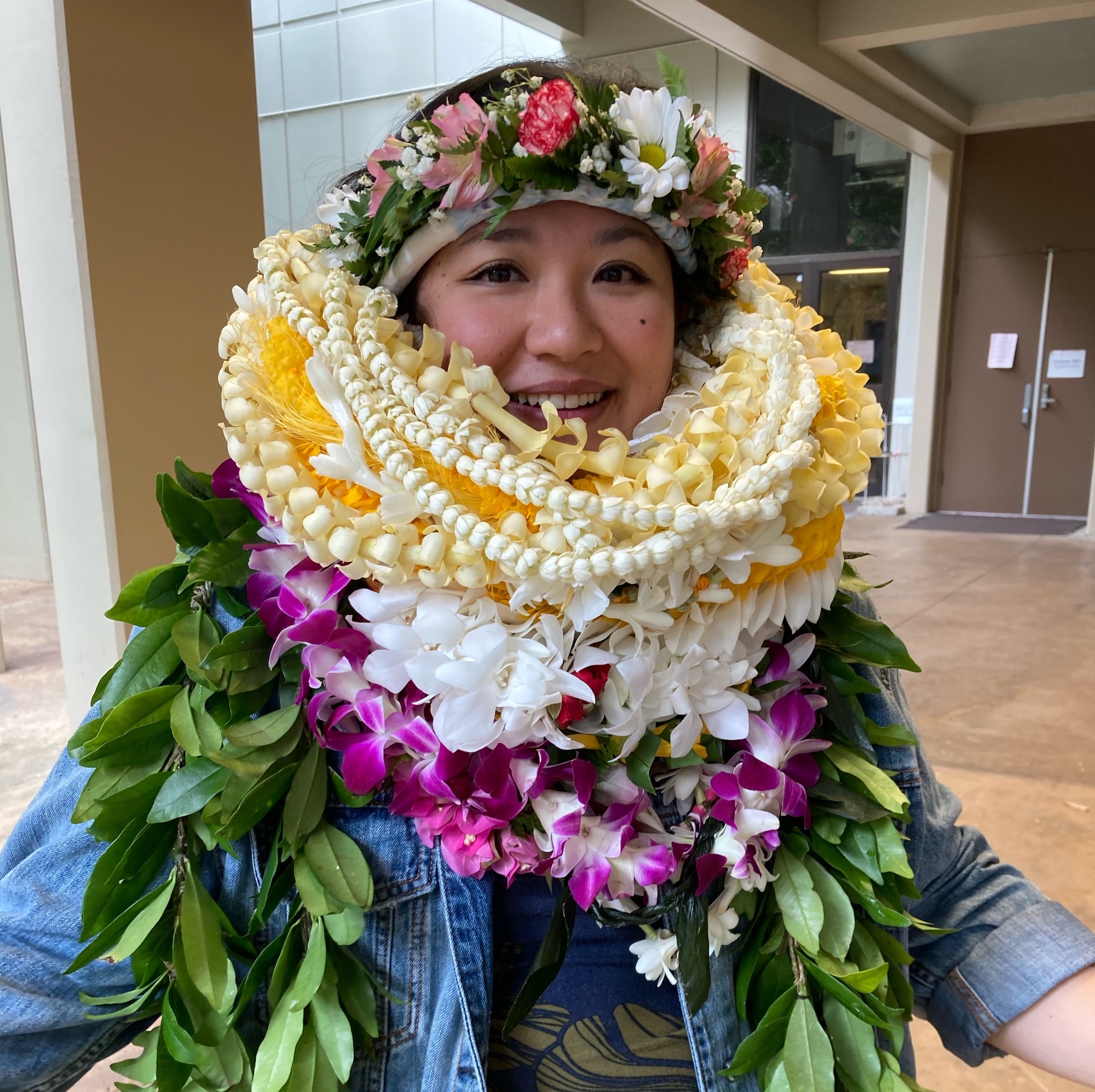Love of ʻāina, community, culture motivated graduate through doctoral degree
 Diamond Tachera after her dissertation defense.
Diamond Tachera after her dissertation defense. Diamond Tachera, a life-long student in Mānoa Valley, joins the Spring 2022 commencement celebration after completing a doctoral degree in Earth Sciences at the University of Hawai‘i at Mānoa School of Ocean and Earth Science and Technology (SOEST).
Though she grew up in Kalama Valley, O‘ahu, Tachera considers Mānoa as part of her home—having attended University Laboratory School from kindergarten through high school. In her senior year, Tachera’s science teacher Lauren Kaupp, who received her Master’s degree in oceanography from SOEST and a doctoral in education at UH Mānoa, invited Tachera to walk around campus during the 2009 biennial SOEST Open House event.
“We accidentally opened the door on Dr. Gerard Fryer, who was practicing his presentation for later that day,” said Tachera. “He invited us in for a private lecture on tsunamis and earthquakes in Hawaiʻi. At that time, I wanted to be a geophysicist and study earthquakes, so it was a truly magical experience! I will never forget the kindness that Gerard shared in that moment, and how warm and comforting it felt to be in that space.”
Tachera attended Kapiʻolani Community College (KCC) for two years, worked in the KCC STEM Center with Aunty Keolani Noa, and was recruited into the first cohort of the SOEST Maile Mentoring Bridge Program. Once she transferred to UH Mānoa SOEST, Tachera pursued an undergraduate degree in the Department of Earth Sciences (formerly Geology and Geophysics) where she immersed herself in learning about Earth system processes, engaged with mentors and found additional inspiration for her pursuits.
Fascinated by everything geology, Tachera pursued undergraduate internships in coastal geology assessing sand transport and with the USGS Pacific Islands Water Science Center, and a senior research project working with Earth Sciences professor Julia Hammer and graduate student Emily First analyzing the mineralogy and eruptive patterns of a volcano in Chile.
“Working with incredibly supportive wahine was a really great experience,” said Tachera.
Mentors encourage graduate school
Through the internships and research experience, her passion for earth science continued to grow and she completed her bachelor’s degree in geology and geophysics in 2016. But she was unsure about enrolling in the graduate program.
“I doubted myself but with encouragement from some of my mentors, such as Barb Bruno and Tiffany Anderson, I applied to graduate school.”
For her doctoral research, Tachera focused on understanding the geochemical changes of water as it moves through the water cycle of West Hawaiʻi Island with SOEST researcher Nicole Lautze as her advisor. She collected more than two years of data on rainfall and groundwater to better understand vital freshwater resources in the area.
“I really wanted to do research that was focused in Hawaiʻi. I am truly grateful for this opportunity, because the research was more than a job to me,” said Tachera. “It was a powerful experience to work on a project that would hopefully benefit the Native Hawaiian community especially as we continue to face climate change impacts more and more each year.”
Representation and Indigenous knowledge in science
Through the process, Tachera’s kuleana and interest grew for increasing diversity, equity and inclusion of Indigenous knowledge in STEM disciplines.
“Growing up, being Hawaiian was just a part of everyday life,” said Tachera. “When I became a student at UH, I really felt a sense of Hawaiian pride. My academic and personal journey over the past 12 years has led me to focus my energy and research on issues that are important to our local community and also motivated me to work toward making geoscience more inclusive and equitable.”
Toward that end, Tachera published an article in late 2021 in the journal Eos outlining a powerful approach to increase equity and inclusion of Indigenous knowledge and communities in science—reframing funding strategies.
“The geosciences are historically exclusive,” said Tachera. “Updating funding systems is just one step toward greater inclusion and accountability across all levels of academia and will result in science that is mutually beneficial to, and respectful of, everyone involved.”
See SOEST News story for more on the Eos article.
Turning to the past for future sustainability
For her next endeavor, Tachera was selected as a postdoctoral fellow for the Advanced Studies Program at the National Corporation for Atmospheric Research (NCAR). The focus of her research will be on combining various data sets, such as historical Hawaiian language nūpepa (newspapers), traditional mo’olelo (stories) and western scientific reports to provide new insights that support sustainable water resources and address potential changes in climate patterns over the last few centuries.
“This support from NCAR to integrate science and culture is really exciting,” said Tachera. “It’s so meaningful to me to have opportunities that elevates Hawaiian history, culture, and people, and that really focus on outputs that benefit my community.”
In the future, Tachera hopes to return to Hawaiʻi to continue her passions as an earth scientist, conducting research that bring Indigenous and Western sciences together, as well as serving as a mentor to future Native Hawaiian scientists who would like to pursue careers that serve the lāhui and are rooted in ʻāina.
Read also on UH News.



